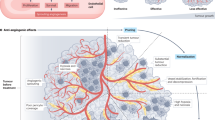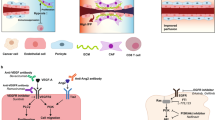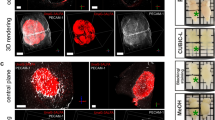Abstract
The vasculature of solid tumours is morphologically aberrant and characterized by dilated and fragile vessels, intensive vessel sprouting and loss of hierarchical architecture1. Constant vessel remodelling leads to spontaneous haemorrhages2 and increased interstitial fluid pressure in the tumour environment3,4. Tumour-related angiogenesis supports tumour growth and is also a major obstacle for successful immune therapy as it prevents migration of immune effector cells into established tumour parenchyma2,5,6. The molecular mechanisms for these angiogenic alterations are largely unknown. Here we identify regulator of G-protein signalling 5 (Rgs5) as a master gene responsible for the abnormal tumour vascular morphology in mice. Loss of Rgs5 results in pericyte maturation, vascular normalization and consequent marked reductions in tumour hypoxia and vessel leakiness. These vascular and intratumoral changes enhance influx of immune effector cells into tumour parenchyma and markedly prolong survival of tumour-bearing mice. This is the first demonstration, to our knowledge, of reduced tumour angiogenesis and improved immune therapeutic outcome on loss of a vascular gene function and establishes a previously unrecognized role of G-protein signalling in tumour angiogenesis.
This is a preview of subscription content, access via your institution
Access options
Subscribe to this journal
Receive 51 print issues and online access
$199.00 per year
only $3.90 per issue
Buy this article
- Purchase on SpringerLink
- Instant access to full article PDF
Prices may be subject to local taxes which are calculated during checkout




Similar content being viewed by others
References
Hanahan, D. & Folkman, J. Patterns and emerging mechanisms of the angiogenic switch during tumorigenesis. Cell 86, 353–364 (1996)
Ryschich, E., Schmidt, J., Hammerling, G. J., Klar, E. & Ganss, R. Transformation of the microvascular system during multistage tumorigenesis. Int. J. Cancer 97, 719–725 (2002)
Heldin, C. H., Rubin, K., Pietras, K. & Ostman, A. High interstitial fluid pressure — an obstacle in cancer therapy. Nature Rev. Cancer 4, 806–813 (2004)
Jain, R. K., Tong, R. T. & Munn, L. L. Effect of vascular normalization by antiangiogenic therapy on interstitial hypertension, peritumor edema, and lymphatic metastasis: insights from a mathematical model. Cancer Res. 67, 2729–2735 (2007)
Ganss, R., Arnold, B. & Hammerling, G. J. Mini-review: overcoming tumor-intrinsic resistance to immune effector function. Eur. J. Immunol. 34, 2635–2641 (2004)
Buckanovich, R. J. et al. Endothelin B receptor mediates the endothelial barrier to T cell homing to tumors and disables immune therapy. Nature Med. 14, 28–36 (2008)
Morikawa, S. et al. Abnormalities in pericytes on blood vessels and endothelial sprouts in tumors. Am. J. Pathol. 160, 985–1000 (2002)
Song, S., Ewald, A. J., Stallcup, W., Werb, Z. & Bergers, G. PDGFRβ+ perivascular progenitor cells in tumours regulate pericyte differentiation and vascular survival. Nature Cell Biol. 7, 870–879 (2005)
Benjamin, L. E., Golijanin, D., Itin, A., Pode, D. & Keshet, E. Selective ablation of immature blood vessels in established human tumors follows vascular endothelial growth factor withdrawal. J. Clin. Invest. 103, 159–165 (1999)
Berger, M., Bergers, G., Arnold, B., Hammerling, G. J. & Ganss, R. Regulator of G-protein signaling-5 induction in pericytes coincides with active vessel remodeling during neovascularization. Blood 105, 1094–1101 (2005)
Ryschich, E. et al. Molecular fingerprinting and autocrine growth regulation of endothelial cells in a murine model of hepatocellular carcinoma. Cancer Res. 66, 198–211 (2006)
Seaman, S. et al. Genes that distinguish physiological and pathological angiogenesis. Cancer Cell 11, 539–554 (2007)
Hollinger, S. & Hepler, J. R. Cellular regulation of RGS proteins: modulators and integrators of G protein signaling. Pharmacol. Rev. 54, 527–559 (2002)
Chen, C., Zheng, B., Han, J. & Lin, S. C. Characterization of a novel mammalian RGS protein that binds to Gα proteins and inhibits pheromone signaling in yeast. J. Biol. Chem. 272, 8679–8685 (1997)
Allt, G. & Lawrenson, J. G. Pericytes: cell biology and pathology. Cells Tissues Organs 169, 1–11 (2001)
Manome, Y., Saeki, N., Yoshinaga, H., Watanabe, M. & Mizuno, S. A culture device demonstrates that hydrostatic pressure increases mRNA of RGS5 in neuroblastoma and CHC1-L in lymphocytic cells. Cells Tissues Organs 174, 155–161 (2003)
Bondjers, C. et al. Transcription profiling of platelet-derived growth factor-B-deficient mouse embryos identifies RGS5 as a novel marker for pericytes and vascular smooth muscle cells. Am. J. Pathol. 162, 721–729 (2003)
Ganss, R. & Hanahan, D. Tumor microenvironment can restrict the effectiveness of activated antitumor lymphocytes. Cancer Res. 58, 4673–4681 (1998)
Ganss, R., Ryschich, E., Klar, E., Arnold, B. & Hammerling, G. J. Combination of T-cell therapy and trigger of inflammation induces remodeling of the vasculature and tumor eradication. Cancer Res. 62, 1462–1470 (2002)
Garbi, N., Arnold, B., Gordon, S., Hammerling, G. J. & Ganss, R. CpG motifs as proinflammatory factors render autochthonous tumors permissive for infiltration and destruction. J. Immunol. 172, 5861–5869 (2004)
Jain, R. K. Normalization of tumor vasculature: an emerging concept in antiangiogenic therapy. Science 307, 58–62 (2005)
Batchelor, T. T. et al. AZD2171, a pan-VEGF receptor tyrosine kinase inhibitor, normalizes tumor vasculature and alleviates edema in glioblastoma patients. Cancer Cell 11, 83–95 (2007)
Winkler, F. et al. Kinetics of vascular normalization by VEGFR2 blockade governs brain tumor response to radiation: role of oxygenation, angiopoietin-1, and matrix metalloproteinases. Cancer Cell 6, 553–563 (2004)
Casanovas, O., Hicklin, D. J., Bergers, G. & Hanahan, D. Drug resistance by evasion of antiangiogenic targeting of VEGF signaling in late-stage pancreatic islet tumors. Cancer Cell 8, 299–309 (2005)
Boss, C. N. et al. Identification and characterization of T-cell epitopes deduced from RGS5, a novel broadly expressed tumor antigen. Clin. Cancer Res. 13, 3347–3355 (2007)
Furuya, M. et al. Expression of regulator of G protein signalling protein 5 (RGS5) in the tumour vasculature of human renal cell carcinoma. J. Pathol. 203, 551–558 (2004)
Chen, X. et al. Novel endothelial cell markers in hepatocellular carcinoma. Mod. Pathol. 17, 1198–1210 (2004)
Brix, G. et al. Pharmacokinetic parameters in CNS Gd-DTPA enhanced MR imaging. J. Comput. Assist. Tomogr. 15, 621–628 (1991)
Hata, R. et al. A reproducible model of middle cerebral artery occlusion in mice: hemodynamic, biochemical, and magnetic resonance imaging. J. Cereb. Blood Flow Metab. 18, 367–375 (1998)
Lin, T. N., He, Y. Y., Wu, G., Khan, M. & Hsu, C. Y. Effect of brain edema on infarct volume in a focal cerebral ischemia model in rats. Stroke 24, 117–121 (1993)
Acknowledgements
We thank G. Küblbeck, A. Klevenz, G. Hollman and S. Schmidt for technical support in establishing Rgs5-knockout mice, K. Bieber for assessing brain ischaemia, B. Misselwitz for providing the contrast agent Gadomer, and H. Ee and G. Bergers for critical reading of the manuscript. This study was supported by a National Health and Medical Research Council of Australia Project Grant, start-up funds from the Western Australian Institute for Medical Research and University of Western Australia (to R.G.), the Deutsche Forschungsgemeinschaft, and the EU projects MUGEN and CancerImmunoTherapy. Microscopy was carried out using facilities at the Centre for Microscopy and Microanalysis/Biomedical Image and Analysis Facility, The University of Western Australia, which are supported by University, State and Federal Government funding.
Author Contributions J.H. and M.M. performed animal experiments and histology, and analysed data; M.J. and F.K. performed MRI analyses; P.R. performed confocal microscopy studies; H.H.M and T.R. coordinated and analysed brain infarct experiments; S.K. and H.-J.G. performed electron microscopy; G.J.H. and B.A. contributed to the design of Rgs5-knockout studies; and R.G. designed and performed experiments, coordinated all studies and wrote the manuscript.
Author information
Authors and Affiliations
Corresponding author
Supplementary information
Supplementary information
This file contains Supplementary Figures 1-6 with Legends and Supplementary Table 1. This file was updated on 16 May 2008 to include Supplementary Table 1 which was inadvertently omitted in production. (PDF 905 kb)
Rights and permissions
About this article
Cite this article
Hamzah, J., Jugold, M., Kiessling, F. et al. Vascular normalization in Rgs5-deficient tumours promotes immune destruction. Nature 453, 410–414 (2008). https://doi.org/10.1038/nature06868
Received:
Accepted:
Published:
Issue date:
DOI: https://doi.org/10.1038/nature06868
This article is cited by
-
Immunotherapy combined with apatinib in the treatment of advanced or metastatic gastric/gastroesophageal tumors: a systematic review and meta-analysis
BMC Cancer (2024)
-
Milestones in tumor vascularization and its therapeutic targeting
Nature Cancer (2024)
-
RGS5 augments astrocyte activation and facilitates neuroinflammation via TNF signaling
Journal of Neuroinflammation (2023)
-
Angiogenic signaling pathways and anti-angiogenic therapy for cancer
Signal Transduction and Targeted Therapy (2023)
-
Molecular mechanisms of coronary artery disease risk at the PDGFD locus
Nature Communications (2023)



